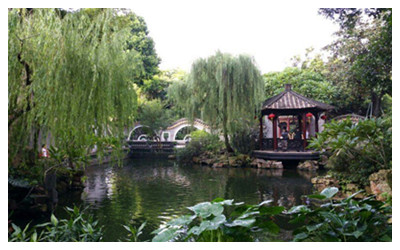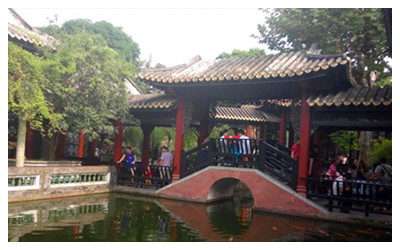Skype: neodalle-travel
Tel: +86 135 7447 2266
E-mail: sales@visitaroundchina.com
What to see?
 Comprising crystal waters, verdant trees, stone formations, bridges, pavilions and towers, the Qinghui Garden that combines ancient gardens, architecture and carvings is well worth a visit.
Comprising crystal waters, verdant trees, stone formations, bridges, pavilions and towers, the Qinghui Garden that combines ancient gardens, architecture and carvings is well worth a visit.
As a perfect integration of the culture of the Ming and Qing Dynasties (1644-1911), South China gardening art and river township architecture, the present Qinghui Garden is a picturesque land which draws visitors worldwide. Covering an area of 0.82 acres, the exquisite garden consists of three parts, as follows: the spacious southern part is characterized by charming waterscape and delicate pavilions; comprising a variety of distinctive architectures, the central part epitomizes garden design; and the northern part with its ancient courts is relatively serene and quiet.
 The beautiful garden draws inspiration from the famous Classical Gardens of Suzhou and demonstrates high quality landscape architecture. Inside its close-knit structure, winding paths will lead visitors to secluded sports; a stroll in the compact garden will lead to a changing scene as one advances forward. Furthermore, the outstanding gardening skills are in evidence in the extensive array of decorative potteries, statues, ornamental glasses and carvings featuring trees, flowers and birds of South China, as well as hollow woodcarvings and brick carvings. A great number of wonderful poems and couplets from ancient celebrities adds a cultural dimension to the ingenious garden.
The beautiful garden draws inspiration from the famous Classical Gardens of Suzhou and demonstrates high quality landscape architecture. Inside its close-knit structure, winding paths will lead visitors to secluded sports; a stroll in the compact garden will lead to a changing scene as one advances forward. Furthermore, the outstanding gardening skills are in evidence in the extensive array of decorative potteries, statues, ornamental glasses and carvings featuring trees, flowers and birds of South China, as well as hollow woodcarvings and brick carvings. A great number of wonderful poems and couplets from ancient celebrities adds a cultural dimension to the ingenious garden.
 It landscapes assemble all the splendor of Chinese traditional gardens, together with graceful pavilions, arbors, halls, rooms, verandas, corridors and boats, all of which are characterized by their robust construction, in the local tradition. The most representative is Chuan Ting (Boat Hall), a specific Chinese garden building which is presented in the fashion of a gaily-painted pleasure-boat. The two-storey building lies on land and is decorated with lifelike carvings of bamboo plants, snails, ripples and other designs. The undulating corridor creates the illusion of being on a ship which is in the harbor.
It landscapes assemble all the splendor of Chinese traditional gardens, together with graceful pavilions, arbors, halls, rooms, verandas, corridors and boats, all of which are characterized by their robust construction, in the local tradition. The most representative is Chuan Ting (Boat Hall), a specific Chinese garden building which is presented in the fashion of a gaily-painted pleasure-boat. The two-storey building lies on land and is decorated with lifelike carvings of bamboo plants, snails, ripples and other designs. The undulating corridor creates the illusion of being on a ship which is in the harbor.
Also of note is the cased glass cutting. The cased glass cutting is rather precious in the glass arts of the Qing Dynasty (1644-1911), and it has been widely used in the buildings of the Qinghui Garden. Cased glass cuttings featuring the eight most famous scenic spots of Guangdong Province have already been identified as first class government protected cultural relics.
There are over 100 varieties of plants, including the purple bamboo trees, wisterias, Chinese hollies, five-needle pines, golden larches and other species from the Classical Gardens of Suzhou, Shandong and Beijing. Some ginkgo trees, longan trees and yews have lived for hundreds of years, and they complement the extraordinary buildings of the garden. In addition, the garden has a tremendous collection of rare stones from all over the country.
Travel Tips
Add: 23, Qinghui Road, Daling Town, Shunde District,Foshan City
Opening Hours: 08:00-18:00
Entrance Fee: CNY 20
http://www.qinghuiyuan.com/
 Ask Questions ?
Ask Questions ?